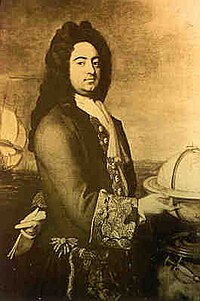Siege of Port Royal (1710)
| Siege of Port Royal | |||||||
|---|---|---|---|---|---|---|---|
| Part of Queen Anne's War | |||||||
 Portrait believed to be of Francis Nicholson, by Michael Dahl, c. 1710 |
|||||||
|
|||||||
| Belligerents | |||||||
|
Iroquois |
Wabanaki Confederacy Mi'kmaq Abenaki |
||||||
| Commanders and leaders | |||||||
|
Francis Nicholson Shadrach Walton Cyprian Southack |
Daniel d'Auger de Subercase Simon-Pierre Denys de Bonaventure |
||||||
| Strength | |||||||
| about 2,000 | fewer than 300 | ||||||
| Casualties and losses | |||||||
| unknown | unknown | ||||||
The Siege of Port Royal (5 – 13 October 1710), also known as the Conquest of Acadia, was conducted by British regular and provincial forces under the command of Francis Nicholson against a French Acadian garrison and the Wabanaki Confederacy under the command of Daniel d'Auger de Subercase, at the Acadian capital, Port Royal. The successful British siege marked the beginning of permanent British control over the peninsular portion of Acadia, which they renamed Nova Scotia, and it was the first time the British took and held a French colonial possession. After the French surrender, the British occupied the fort in the capital with all the pomp and ceremony of having captured one of the great fortresses of Europe, and renamed it Annapolis Royal.
The siege was the third British attempt during Queen Anne's War to capture the Acadian capital, and it had profound consequences over the next 50 years. The conquest was a key element in the framing of the North American issues in French-British treaty negotiations of 1711–1713. It resulted in the creation of a new colony—Nova Scotia—and introduced significant questions concerning the fate of both the Acadians and the Mi'kmaq who continued to occupy Acadia.
The Conquest of Acadia was a foundational moment in the history of the Canadian state — it was a precursor to the British conquests of Louisbourg and Quebec, and it portended the end of French power in North America more generally.
Port Royal was the capital of the French colony of Acadia almost since the French first began settling the area in 1604. It consequently became a focal point for conflict between English and French colonists in the next century. It was destroyed in 1613 by English raiders led by Samuel Argall, but eventually rebuilt. In 1690 it was captured by forces from the Province of Massachusetts Bay, although it was restored to France by the Treaty of Ryswick.
...
Wikipedia
